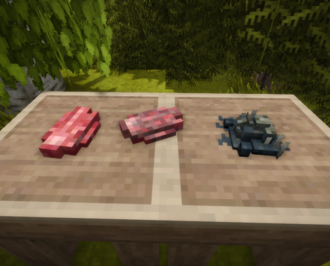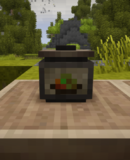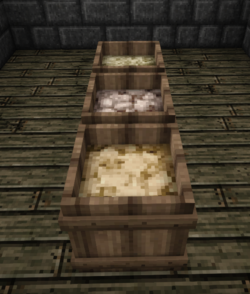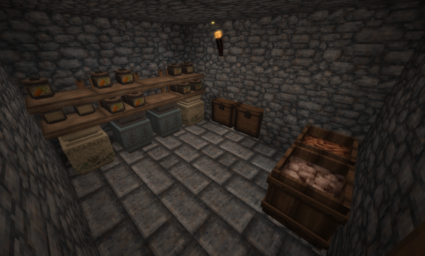Conservación de Alimentos
La mayoría de comidas tienen un tiempo de descomposición, en el sentido que se descompondrá con el tiempo, perdiendo valor nutricional, y eventualmente convirtiéndose en putrefacción. Para combatir esto, existen ciertos metodos de preservación para mantener tu suministro de alimentos fresco, como contenedores de almacenamiento especiales y bodegas.
Vida Útil
Cada alimento tiene un diferente "tiempo de descomposición", que está compuesto por su "tiempo fresco", que es el tiempo que le toma a una comida fresca para empezar a descomponerse; y su "tiempo de putrefacción", que es el tiempo antes que un objeto se transforme completamente en putrefacción.
All combinar stacks de comidas, el promedio de sus tiempos de descomposición se convertirá en su nuevo tiempo de descomposición para ambos objetos.
Factors affecting food spoilage
The perish time of a food item can be longer or shorter depending on a variety of circumstances:
Climate
The climate in which the food is stored affects the rate of food spoilage. Hot climates can increase the decay rate up to 2.5x (250%), while very cold climates can reduce the decay rate down to 0.1x (10%). Only the climate at sea level is considered, so placing your food high up in the mountains will have no effect if the mountain is in a hot climate.
You can however completely negate the impact of climate by building a cellar.
Food type
Different types of foods have different lifetimes. As mentioned before, food items remain 100% fresh for a specific time period (shown in the tables above). After this time, food items begin to decay at a rate affected by storage containers, storage locations, and climate conditions. As food items decay, they lose nutrition value and will eventually become "rot". The food items with the highest perish time from each category are: Cured meat (meats), Pineapple (fruits), Soybean/Peanuts (vegetables), Flour (grain), and Waxed Cheddar Cheese (dairy).
Food preservation containers
While food can be stored in any stationary container, storage vessels are best for storing grains and vegetables. Storage vessels and crocks are fairly easy to make, requiring only clay. However to increase the shelf life of meats and vegetables, combining preserving methods with containers is best.
Crocks
Can hold up to 4 portions of meals or pickled vegetables can be stored in crocks providing a slight reduction in food decay, which is a good option for short term food storage. For long term storage, sealing the crocks with a lump of fat or beeswax above the crock in the crafting grid reduces decay by a factor of 10. Filled crocks may be carried in player inventories. For convenience you can build shelves that can hold up to 8 crocks at a time.
Storage Vessels
Any food item can be stored in vessels, which provide storage benefits to preserved foods as well as raw foods. These vessels are good options for short and long term food storage as they reduce decay 75% for veggies and 50% for grains.
Food preservation processes
Almost all types of food items can be stored in the form of cooked meals, but it’s not always practical to do so. For this, there’s special food processing methods that increase their lifespan significantly. Due to the different components in foods, there are various processes to preserve each type or category of food.
Jam (Preserving Berries)
Making jam requires a cooking pot, a bucket, honey, and berries. By using a cooking pot, add a minimum of two berries and two units of honey to make jam. For the longest shelf life, jam should be stored in a sealed crock.
Salt Curing (Preserving Meats)
Curing meats requires a barrel, salt and the raw meat to preserve. Each unit of meat requires two units of salt, i.e. 32 meat = 64 salt. After adding the appropriate ingredients into the input slot of the barrel, the GUI will state the process yield. At this point the barrel must be sealed for 480 hours to complete the curing process.
Pickling (Preserving Vegetables)
Pickling vegetables requires a barrel, a bucket, salt, water, and the vegetables to preserve. Water and salt are mixed in the barrel to make brine before adding the vegetables. Otherwise, the process of pickling is very similar to salt curing. Each vegetable or legume uses one unit of brine and the barrel must remain sealed for 336 hours. Once the food items are pickled or salt preserved, they can be stored in any stationary container, though storage vessels are best.
Cheese (Preserving Milk)
Milk can be turned into cheese by processing it in several steps with pickled vegetables and salt in a barrel. See the cheesemaking section for more details.
Food preservation locations
To negate the impact of a warm climate, build a cellar. Cellars have a fixed temperature of 5°C or colder if the ambient temperature is lower, meaning you will only profit from a cellar if the outside temperature is higher than 8°C in the first place.
Recommendations
- Build the walls from soil, ceramic, or stone materials and keep door/trapdoor count low. It’s best to not use any doors/trapdoors, and instead use dirt or hay as full-block fillers. The less light inviting openings the cellar has, the better - additionally, doors do not count as a soil or stone block and thus lower the efficiency, even if they do not let in sunlight.
- Keep the sun light level inside the cellar low, as it can raise the temperature by up to 10°C, thus influencing spoilage rate. Artificial lights like lanterns, torches and oil lamps are fine. This means building a cellar underground can help reduce the entry of sunlight, but it doesn't give a bonus solely on the fact it’s underground. Cellars can be located above ground, as long as they are safe from the sun.
- Cellars should be no larger than 7x7x7 blocks inside. If the room exceeds these dimensions, it will not be recognized as a cellar. Only the direct walls count, the corner rows can be left out without affecting the room recognition.
- Once a cellar is created any food items may be placed on a shelf or inside containers. A typical cellar layout is filled with crocks on shelves, storage vessels, chests and barrels of pickled food. All items stored in the cellar will receive equal food decay reduction.
Protip:
Players can verify the storage benefit by looking at the block info HUD of a shelf or storage container. It will display something like Stored food perish speed: 0.25 in this case meaning food will last 4 times longer. |
Removing the Rot from Bowls, Pots and Crocks
If food has rotten inside a food container such as a bowl, pot, or crock, you just need to throw it in water and, after a few seconds, the rot will float out of the container. For sealed crocks, you might need to unseal it first (getting a food portion with a bowl).
| {{{title}}} | |
|---|---|




